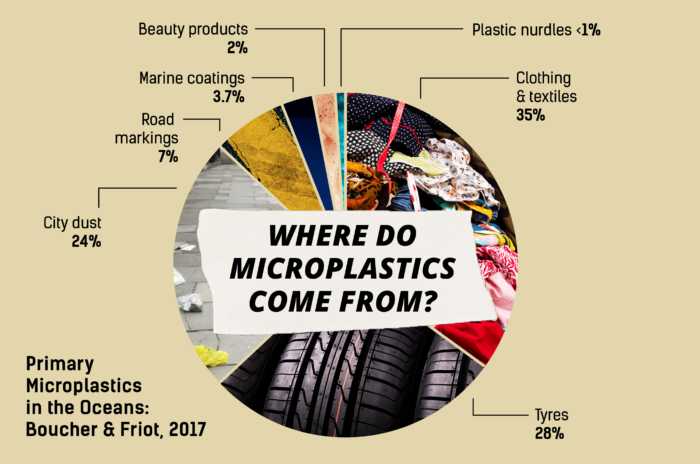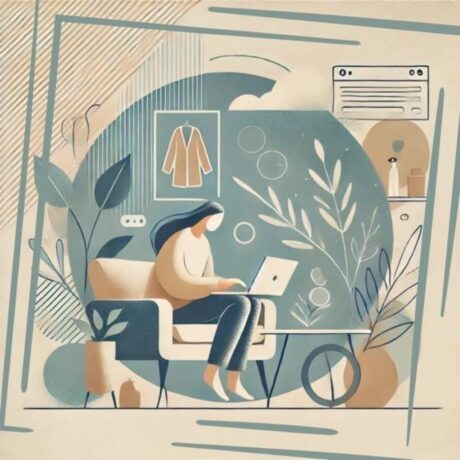Our clothes shed microfibres – here’s what we can do…
During the month of February, we’ve been exploring fashion’s impact on water and looking at how we can practice water stewardship through our wardrobes. So far, we’ve discussed the consequences of industrial dyes, misconceptions around water consumption, and better laundry habits to conserve water. Now, we’re taking a look at how our wardrobes affect our oceans when they release microfibres.
What are microfibres?
Microplastics are tiny plastic pieces that are less than <5 mm in length. Textiles are the largest source of primary microplastics (specifically manufactured to be smaller than 5mm), accounting for 34.8% of global microplastic pollution [1]. Microfibres are a type of microplastic released when we wash synthetic clothing – clothing made from plastic such as polyester and acrylic. These fibres detach from our clothes during washing and go into the wastewater. The wastewater then goes to sewage treatment facilities. As the fibres are so small, many pass through filtration processes and make their way into our rivers and seas.
Around 50% of our clothing is made from plastic [2] and up to 700,000 fibres can come off our synthetic clothes in a typical wash [3]. As a result, if the fashion industry continues as it is, between the years 2015 and 2050, 22 million tonnes of microfibres will enter our oceans [4].

What impact do microfibres have on the environment and on human health?
Due to the tiny size of microplastics, they can be ingested by marine animals which can have catastrophic effects on the species and the entire marine ecosystem.
Microfibres can absorb chemicals present in the water or sewage sludge, such as polychlorinated biphenyls (PCBs) and carcinogenic Persistent Organic Pollutants (PoPs). They can also contain chemical additives, from the manufacturing phase of the materials, such as plasticisers (a substance added to improve plasticity and flexibility of a material), flame retardants and antimicrobial agents (a chemical that kills or stops the growth of microorganisms like bacteria). These chemicals can leach from the plastic into the oceans or even go straight into the bloodstream of animals that ingest the microfibres. Once ingested, microfibres can cause gut blockage, physical injury, changes to oxygen levels in cells in the body, altered feeding behaviour and reduced energy levels, which impacts growth and reproduction [5][6]. Due to this, the balance of whole ecosystems can be affected, with the impacts travelling up the food chain and sometimes making their way into the food we eat! It has been suggested that people that eat European bivalves (such as mussels, clams and oysters) can ingest over 11,000 microplastic particles per year [7].
What can fashion brands do?
The fashion industry needs to take responsibility for minimising future microfibre releases. Brands can have the most impact if they take microfibre release into consideration at the design and manufacturing stages. Designers should consider several criteria in order to minimise the environmental impact of a synthetic garment [3]:
- Use textiles which have been tested to ensure minimal release of synthetic microfibres into the environment.
- Ensure the product is durable so it remains out of landfill as long as possible
- Consider how the garment and textile waste could be recycled, to achieve a circular system.
During manufacture, there are several methods that can be applied to reduce microfibre shedding such as brushing the material, using laser and ultrasound cutting [4], coatings and pre-washing garments [1]. The length of the yarn, type of weave, and method for finishing seams may all be factors affecting shedding rates. However, much more research from brands needs to occur in order to determine best practices in reducing microfibres and create industry-wide solutions.
Waste-water treatment…
Waste-water treatment plants (where all our used water gets filtered and treated) are currently between 65-90% efficient at filtering microfibres [6]. Research and innovations into improving the efficiency of capturing microfibres in wastewater treatment plants is essential to prevent them escaping into our environment.
Washing machine filters…
Improving and developing commercial washing machine filters that can capture microfibres may allow for an additional level of filtration, whilst also educating consumers and businesses [8]. However, current filters which need to be fitted by the user, such as that developed by Wexco, are currently expensive and reportedly difficult to install. They also place a financial burden upon the consumers, rather than pressurising brands to commit to change. To tackle this, we need more industry research and legislation to ensure all new washing machines are fitted with effective filters to capture the maximum amount of microfibres possible. However, we then have the issue of what to do with the microfibres once we have caught them – an area which requires more research and industry collaboration.
Collaboration is key
Collaboration across multiple industries is required if we are to tackle microfibre pollution. In addition to material research, waste management and washing machine research and development, there is a role for other sectors such as detergent manufacturers and the recycling industry to come together to help reduce microfibre pollution. Cross-industrial agreements could help promote collaboration between industry bodies and promote sharing of resources and knowledge.
A major issue has been a lack of a standardised measure of measuring microfibre release. However, a cross-industry group, The Microfibre Consortium recently announced the first microfibre test method. The launch will enable its members (including brands, detergent manufacturers and research bodies) to accelerate research that leads to product development change and a reduction in microfibre shedding in the fashion, sport, outdoor and home textiles industries. The Microfibre Consortium also works to develop practical solutions for the textile industry to minimise microfibre release to the environment from textile manufacturing and product life cycles.
The need for microfibre legislation
Comprehensive legislative action is needed to send a strong message and force the brands to address microfibre releases from their textiles. This is a complicated issue that will require policymakers to tackle this issue on many different levels and sectors. Currently, there are no EU regulations that address microfibre release by textiles, nor are they included in the Water Framework Directive.
However, there have been several developments in microfibre legislation in the past few years:
- As of February 2020, Brune Poirson, French Secretary of State for the Ecological and Inclusive Transition, is the first politician in the world to pass microfibre legislation. As of January 2025, all new washing machines in France will have to include a filter to stop synthetic clothes from polluting our waterways. This makes France the first country in the world to take legislative steps in the fight against plastic microfibre pollution. The measure is included in the anti-waste law for a circular economy.
- In 2018, US states of California and Connecticut proposed legislation which would see polyester garments legally required to bear warning labels regarding their potential to shed microfibres during domestic washing cycles. However, this legislation is yet to be passed.
- In 2019, the EAC urged the UK government to accelerate research into the relative environmental performance of different materials, particularly with respect to measures to reduce microfibre pollution, as part of an Extended Producer Responsibility scheme. However, the UK government rejected the proposal stating that current voluntary measures are sufficient.
What can you do?
Write to your policymaker
It is vital that policy is put into place to tackle microfibres, such as the new French washing machine filter legislation. If you are concerned about microfibres, we encourage you to write to your policy representative and urge your government to take action on microfibre pollution. Now that France has enacted the microfibre legislation, it raises the bar for other governments to also take action, but they will only do so with enough pressure from the people they represent – you!
Changing your washing practices
The easiest thing you can do to minimise microfibres releasing from your clothing is to simply wash your clothes less. Given that up to 700,000 microfibres can detach in a single wash [3] ask yourself if that item really needs to be washed or can it be worn once or twice more before you do?
While some research suggested using a liquid detergent, lower washing machine temperatures, gentler washing machine settings [3] and using a front-loading washing machine [9] can reduce microfibre shedding. Researcher Imogen Napper stated they found that there was no clear evidence suggesting that changing the washing conditions gave any meaningful effect in reducing microfibre release.
You can also use a Cora Ball, a guppy bag or a self-installed washing machine filter to capture microfibres from your clothing. The CoraBall and Lint LUV-R (an install yourself washing machine filter) have been shown to reduce the number of microfibres in wastewater by an average of 26% and 87%, respectively [10]. Although these can’t solve the problem, we still want to divert as many microplastics as we can from entering our waterways.
Should we all switch from synthetic fibres?
While many people’s first instinct is to switch from synthetic materials to natural materials to minimise microfibre release, this is not always a simple choice as there are other sustainability aspects involved. The UK’s Environmental Audit Committee in their report states ‘A kneejerk switch from synthetic to natural fibres in response to the problem of ocean microfibre pollution would result in greater pressures on land and water use – given current consumption rates’ [11].
Demand brands to do more to take action on microfibres
“Ultimate responsibility for stopping this pollution, however, must lie with the companies making the products that are shedding the fibres.” states the Environmental Audit Committee [11], but there are still too many major fashion brands not taking responsibility for what happens in their supply chains and in the life cycle of their products. As well as demanding action from your policymaker, we should also ask brands what they are doing to minimize the microfibre release from their products. It is clear that there is still a lot of work to do, and as their customers, we have a lot of power in influencing the impacts of the brands we buy.
The impacts of microfibres on the environment can be mitigated, but only with systematic and meaningful change supported by policymakers, brands, industry, NGOs and citizens all working together.
References
[1] Boucher, J. and Friot, D. (2017). Primary Microplastics in the Oceans: A Global Evaluation of Sources. IUCN. Available at: https://portals.iucn.org/library/sites/library/files/documents/2017-002-En.pdf
[2] Textile Exchange (2019). Preferred Fiber and Material Market Report. Available at: https://store.textileexchange.org/wp-content/uploads/woocommerce_uploads/2019/11/Textile-Exchange_Preferred-Fiber-Material-Market-Report_2019.pdf
[3] Napper, I. and Thompson, R. (2016). Release of synthetic microplastic plastic fibres from domestic washing machines: Effects of fabric type and washing conditions. Marine Pollution Bulletin. Available at: https://www.sciencedirect.com/science/article/pii/S0025326X16307639?via%3Dihub
[4] Ellen MacArthur Foundation (2017). A new textiles economy: Redesigning fashion’s future. Available at: https://www.ellenmacarthurfoundation.org/assets/downloads/publications/A-New-Textiles-Economy_Full-Report_Updated_1-12-17.pdf
[5] Koelmans, A., Bakir, A., Burton, G. and Janssen, C. (2016). Microplastic as a Vector for Chemicals in the Aquatic Environment: Critical Review and Model-Supported Reinterpretation of Empirical Studies. Environmental Science & Technology. Available at: https://pubs.acs.org/doi/abs/10.1021/acs.est.5b06069
[6] Henry, B., Laitala, K. and Grimstad Klepp, I. (2018). Microplastic pollution from textiles: A literature review. Consumption Research Norway SIFO. Available at: https://www.hioa.no/eng/About-HiOA/Centre-for-Welfare-and-Labour-Research/SIFO/Publications-from-SIFO/Microplastic-pollution-from-textiles-A-literature-review
[7] Van Cauwenberghe, L. and Janssen, C. (2014). Microplastics in bivalves cultured for human consumption. Environmental Pollution. Available at: https://www.sciencedirect.com/science/article/pii/S0269749114002425
[8] Browne, M., Crump, P., Niven, S., Teuten, E., Tonkin, A., Galloway, T. and Thompson, R. (2011). Accumulation of Microplastic on Shorelines Worldwide: Sources and Sinks. Environmental Science & Technology. Available at: https://pubs.acs.org/doi/abs/10.1021/es201811s
[9] Hartline, N., Bruce, N., Karba, S., Ruff, E., Sonar, S. and Holden, P. (2016). Microfiber Masses Recovered from Conventional Machine Washing of New or Aged Garments. Environmental Science & Technology. Available at: https://pubs.acs.org/doi/abs/10.1021/acs.est.6b03045
[10] McIlwraith, H., Lin, J., Erdle, L., Mallos, N., Diamond, M. and Rochman, C. (2019). Capturing microfibers – marketed technologies reduce microfiber emissions from washing machines. Marine Pollution Bulletin. Available at: https://doi.org/10.1016/j.marpolbul.2018.12.012
[11] Environmental Audit Committee (2019). Fixing Fashion: clothing consumption and sustainability. House of Commons. Available at: https://publications.parliament.uk/pa/cm201719/cmselect/cmenvaud/1952/1952.pdf
Research and writing by Sienna Somers, Policy and Research Co-ordinator at Fashion Revolution








